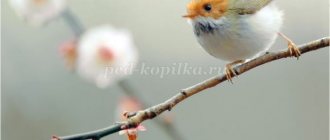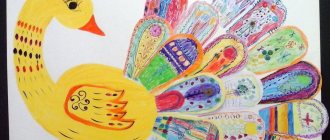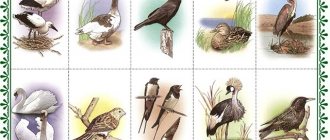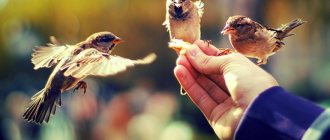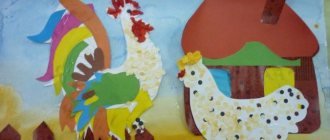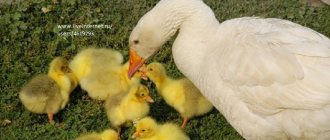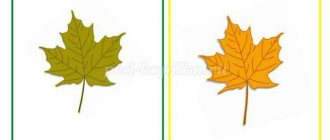What training materials will be needed during the process?
The brighter and more diverse the story about nomadic birds for kindergarteners is, the more it will remain in memory. When preparing, I recommend using your senses as much as possible: eyes, ears and fingers. This means that we will watch pictures and videos, listen to information and poems about birds, and touch feathers with our hands.
The first and most important aid that we use in class is the “Birds of Migratory” poster. It shows all the necessary views, the pictures are large and visible from afar. The birds are well drawn and it is easy to explain from them how one differs from the other (tails, wings, legs, plumage, size). The birds are signed, the most inquisitive children will try to read them.
Flashcards with migratory birds are also very helpful. They have three purposes at once: you can take poems and riddles from the card, and learn the bird’s name in Russian and English. But most importantly, using the cards we give the task to compose a story: describe what wings, legs, color of plumage, etc. the bird has. For example, the presenter talks about the first card. There are also other cards without names. We give them in the second lesson and check recognition.
We look for poems in which lark, swallows, starlings, nightingales, thrushes, storks, rooks, cranes and other birds appear on the Internet or in special teaching aids. There are also fairy tales on the Internet that are interesting for children 6 years old. For example, “On the Lake”, “How Sparrow looked for Africa”, “Returning to the Homeland” and others.
It’s great when you have the opportunity, after a poem or fairy tale, to show a video in which a bird flies, walks, and feeds. You can try to find videos on the Internet and edit short videos, no longer than a minute. There are educational films, video tutorials and educational videos about migratory species on Youtube. But they take time; it’s better to show such a film outside of class. You can watch the cartoon: “Grey Neck”, “Heron Mother”, “Quacked Vacation”, “Flap Your Wing”.
Migratory birds in spring
Oh, how nice it is in the forest! Smells like spring. The snow is melting, the first insects appear. Trills, chirping and birdsong can be heard. After all, the birds that flew to warmer regions in the fall return to their homeland. They enjoy the warmth and sunshine.
Rooks are among the first to arrive. This usually happens in March.
In the old days they said: “If you see a rook, welcome spring!”
The rook is a large black bird with a purple tint. It looks like a carrion crow, but the rook's beak is lighter and the skin around the beak is devoid of feathers. The rook can be up to fifty centimeters in length. Rooks usually live in large colonies, with several dozen nests on one tree.
Rooks build their nests from twigs, lumps of clay, moss, and dry grass.
Rooks communicate with their relatives by cawing loudly.
Starlings follow the rooks. Among the people there was such a sign: “If you see a starling, you know spring is at the porch.”
The starling is a small but very beautiful bird. Its black feathers have a metallic reddish, purple, greenish sheen. There are also white spots scattered here and there.
Everyone knows that starlings are useful birds. They walk on the ground with their heads down, looking for food. With their long beaks they grab beetles, weevils, caterpillars and other insects.
When starlings arrive, people make houses for them - birdhouses. But starlings can also settle in tree hollows and in the voids of outbuildings.
The starling's spring song is good. What sounds can you hear in his song! Starlings can imitate the voices of many birds and animals. In the singing of a starling you can hear the ringing trill of a nightingale, the quack of a wild duck, and the croaking of frogs.
In the old days in Rus' it was believed that birds brought spring on their wings. There was a custom in March to sculpt and bake lark birds from dough. They were attached to long sticks, the children ran out onto the hills with them and sang Russian folk songs:
Larks, come, take away the cold winter, bring the warmth of spring: We are tired of winter, we have eaten all our bread!
A lark is a bird slightly larger than a sparrow. The lark's feathers are grayish-brown, with dark stripes and spots. And the tummy is light. There is a small crest on the head, and the tail is edged with white feathers.
This coloring makes the lark invisible among tufts of grass and plant stems. After all, larks build their nests right on the ground, among the grass.
Larks arrive at the end of March - beginning of April, when the snow begins to melt.
The fields have not yet turned green, but the larks in the blue sky are already fluttering their wings and singing joyfully. Their song sometimes resembles a trill, sometimes like the ringing of bells.
In April, another small bird arrives - the wagtail.
Why did the wagtail get such a strange name? Running on the ground, she constantly shakes her tail with a long tail. The tail is the back part of the body of birds. There is a popular saying: “a wagtail breaks the ice with its tail.” After all, these restless birds arrive when the ice on the rivers begins to break. That is why the wagtail is called an icebreaker.
The song of wagtails is melodic, but simple. Male wagtails sometimes chirp quietly, sometimes squeak quietly, sometimes chirp loudly.
But this brightly colored bird is a finch. The top of his head is bluish-blue, and his chest is light red. But why was the chaffinch called a chaffinch? Maybe because he is freezing, that is, chilly? Not at all. The finch simply flies away in late autumn and arrives in early spring, when it is still very cold and chilly outside.
Finches are not afraid of anything. They can look for food right under a person's feet. And when they sing their wonderful songs, they don’t notice anything or anyone around them. There is a Russian saying that the lark sings for warmth, and the finch sings for frost.
Blackbirds also arrive in April.
Blackbirds usually make their nests on small spruce trees or on juniper bushes. And sometimes even on the ground, in piles of brushwood. There the female lays from three to six bright blue eggs with sparse dark specks.
Song thrushes are considered remarkable singers. Their singing resembles the trills of a nightingale.
In April, other migratory birds also arrive: kites, swans, geese, ducks, herons, cranes, and little warblers.
But in May, swallows, flycatchers, nightingales, orioles, and swifts arrive from warm countries.
For a long time, people have had a special attitude towards the swallow. There are many beliefs associated with it. People say: “An early swallow means a happy year.” A house with a swallow's nest is considered lucky.
Urban white-breasted swallows make their nests under the eaves of stone and wooden houses. Killer whale swallows nest under the roofs of village barns and houses. Shore swallows are found in burrows, which they dig with their sharp claws in the steep slopes of the river bank. Swallows spend almost their entire lives in flight. They very rarely fall to the ground, because their short legs are not adapted to walking on the ground.
The swallow has an elongated body, narrow long wings and a long forked tail.
The chirping of swallows is difficult to hear in the city. Her voice is quiet. And from time to time the chirping is replaced by crackling.
But the nightingale is rightly called one of the best singers. Looking at this small, inconspicuous bird, it is difficult to believe that such wonderful sounds can be produced from such a fragile body. The nightingale is small, but the voice is great.
The nightingale is a very slender, graceful bird, painted in uniform reddish-brown tones. He has rather high legs and a graceful figure. The nightingale has very large dark, almost black eyes.
But this bird is slightly larger than a starling. Look how bright the yellow plumage is! And the wings and tail are black. Moreover, there is a black stripe from the beak to the eyes. And the beak is reddish. This is a male oriole.
But the female oriole looks more modest. Her feathers are not bright yellow, but greenish.
Orioles are wonderful singers. Their singing resembles the sounds of a flute. But sometimes an oriole, worried about something, makes unpleasant sounds reminiscent of a cat meowing.
The swifts arrive later than everyone else. Swifts can be seen in almost every corner of the earth, except Antarctica and several islands. These birds are very similar to swallows. Sometimes they are even confused. But distinguishing a swift from a swallow is quite simple. Swallows have a white breast, while swifts have only a white spot under the beak. The wings of a swift are longer and narrower than those of a swallow. But the tail is wider and shorter.
The swift is the champion among all birds in terms of flight speed. It can reach speeds of up to one hundred and seventy kilometers per hour. But on the ground, these incomparable flyers waddle with difficulty on their short legs, helping themselves with the ends of their wings.
Swifts fly over houses with loud, piercing screams. They seem to tell everyone that warm summer weather has arrived.
Yes, what wonderful creatures birds are!
What to tell children about migratory birds
The main point of the lesson is to tell that birds are living creatures with warm blood. Their body temperature is higher than human, about +41 degrees. To be able to survive the winter cold, birds need a lot of energy. This means more food is required.
Insectivorous and carnivorous birds have nothing to eat in winter, and they fly south to warm countries. Waterfowl are also forced to fly away, because the water in which they look for food freezes. Cranes eat berries, storks and herons eat frogs; in cold weather they also have nothing to eat. Some species that prefer plant foods also fly south. Granivores have one peculiarity - they do not always leave our latitudes.
Birds that fly away for the winter are called migratory or nomadic. And those who remain to spend the winter in their native country are sedentary (wintering). Geese, swans, herons, storks, nightingales, siskins, rooks, starlings, swallows, quails, larks, blackbirds, and orioles go to winter. They move to different countries. Quails - to Africa and Asia, nightingales - to Africa, siskins - to Kazakhstan and the Caucasus. Wintering species include crows, titmice, sparrows, pigeons, magpies, and other species.
They fly in flocks or wedges, and some fly alone (cuckoos, hawks, falcons). In the spring, migratory birds travel back to their native lands to raise their young. They are very useful for nature and humans. Insectivores eat insect pests, while others help maintain the ecosystem. For example, storks eat snakes and locusts.
Kindergarteners will love these fun facts. That birds fly south in a flock, in a direct front, in a wedge or in a school. You can show what it looks like in a presentation or photo. There are folk signs and riddles about migratory birds. Feathered travelers remember their nests and fly there from year to year. Departure time varies: birds make decisions based on the weather and instincts (be prepared to explain what these are). It cannot be otherwise, because they do not read newspapers.
Birds
The first heralds of spring - rooks - arrive in March. They walk slowly and importantly through the snow-free fields, collecting larvae and worms. The rook is easy to recognize. The old rook has bright black plumage and a white patch around the beak. This is what old rooks look like. But young people don’t have such a spot. Spring sowing is underway in the fields. Following the tractors and seeders, rooks walk along the furrow, collecting insects. Not immediately after arrival they begin to build their nests. Rooks usually settle in large groups on tall trees. This is a colony of rooks. The place where these birds settled can be immediately recognized by the strong noise and scream.
Following the rooks, the first larks arrive in March, followed by starlings. The birds do not all arrive at once. First, the first single birds arrive. And after the advanced detachments of rooks and starlings, other birds fly. At the end of March the first larks or starlings arrived, and then there were blackbirds, lapwings, gulls, ducks, swans and other birds.
Migratory birds are in a hurry to get to their native places, build a nest, and raise their chicks.
How do our old friends, the wintering birds, live in the spring? And in the spring they begin to worry about raising chicks.
Spring... A joyful, bright time of year. But for many animals and birds, spring is the most difficult, difficult time and, above all, the hungriest time. The supplies collected in the fall have come to an end; during the long winter, seeds, acorns, berries, nuts, and mushrooms covered under the snow have been eaten. The bark from young aspen and mountain ash trees was gnawed. Upholstered with cones from fir trees. It just seems that the forest is an inexhaustible storehouse. In fact, by spring there is little edible left.
How to create a lesson plan
If this is your first lesson on birds, you need to make a detailed list of what you will tell and show, in what sequence, and make a timeline. It is important where you decide to conduct the lesson - outdoors or indoors. In nature you can hear and sometimes even see birds. But indoors you can watch videos and cartoons. This thematic guide will help you plan a lesson with a descriptive part, games and other tasks.
It is difficult to tell a child about something he did not see. Therefore, kindergarteners need to be shown drawings and videos, and given recordings of birdsong to listen to. By the way, another manual with pictures of migratory and wintering birds, as well as domestic and wild ones. It will help tell you about domestic, forest, waterfowl and other species. Don’t forget to explain that birds live in birdhouses, nests, and hollows. Even better – show it during a walk.
You can build a lesson for kindergarten in the form of a dialogue: ask questions and tell stories. For example: “What season is it now? The days have lengthened and other changes have occurred (list). Have you heard birds singing in the morning? Those who have returned from warmer climes sing - migratory birds. Do you know who migratory birds are?” It is worth mentioning the nomadic birds that come to us for the winter because they are accustomed to the cold (bullfinches, tits).
You can divide the lesson into two or three parts. But do not give them one after another, but take a break of several days. Children need to digest, “live” the information, tell their parents and friends about new knowledge, and discuss it.
One of the lessons can include games for speech development. For example:
- Name the chick (cuckoo - cuckoo, rook - rook, etc.).
- Find the odd one out (choose a non-migratory bird from three or four).
- Call it affectionately (cuckoo - cuckoo, feather - feather, wing - wing, nightingale - nightingale).
I recommend including a variety of games and entertainment in your lesson plan. For example, coloring books and stickers with birds, children's lotto or other games with images of birds, simple origami, finger games. You can give tasks on cards: for example, arrange them in two rows - with migratory and wintering birds.
Wintering and migratory birds in pictures for children aged 4–7 years
Svetlana Petryakina
Wintering and migratory birds in pictures for children aged 4–7 years
Wintering and migratory birds –
in pictures with names for children
How do wintering birds differ from migratory birds? Beautiful pictures of birds, simple stories about each bird and questions for a quiz on the topic “Birds”. The further the progress of science and technology goes, the more disconnected from the surrounding nature our children grow up. Sometimes they cannot say the names of plants and birds that are often found within the city, let alone the inhabitants of the wild forest, especially the winter forest, which children are even less likely to visit than the summer forest. Therefore, it will be useful for every child to conduct a lesson on birds in winter.
Wintering and migratory birds - pictures with names for children
A thematic lesson is structured very simply if wintering and migratory birds depicted in photographs or drawings are used - pictures with names are simply necessary for children, otherwise they will not be able to form stable visual images and remember information that is new to them. Visual perception is usually well developed already in preschool age, so you can start studying such material with preschool children.
A lesson on the topic of wintering birds traditionally begins with a simple question - why does it become difficult for birds to live in cold regions in winter? This is how we voice the main problem and look for its solution. Typically, children offer answer options indicating uncomfortable living conditions in winter: cold, fear of freezing. This theory is refuted by the fact that the birds have well-developed plumage, which means they are not afraid of the cold. (Let's remember goose or swan down, which is used to stuff down jackets - warm winter clothes that people wear with pleasure in any frost).
We gradually lead the child to think about what other needs each representative of the animal kingdom has, including birds. We come to the key need of a living organism - nutrients, and remember what is usually included in the diet of birds: insects, berries and other fruits.
Migratory birds
In winter, all insects hide from the cold - therefore, birds that feed exclusively on this type of food have to fly to warmer climes. This group includes (we show pictures and study birds that migrate from one climate zone to another):
• The flycatcher is an inconspicuous-looking, but very agile bird. It catches its prey on the fly, stalking it from an open hill or other elevated area.
flycatcher
• The garden warbler is a vocal bird that loves to organize night concerts, imitating the voices of other birds. It feeds exclusively on insects.
Garden warbler
• The starling is a well-known inhabitant of the children's numerous spring new buildings - birdhouses. It tries to settle close to humans, as it loves to eat fruits, grains and worms thrown to the surface of the earth during plowing. Sings well and can imitate the voices of other birds.
Starling
• Swallow – previously lived in rocky areas, but has adapted well to life in the city. It is one of the dexterous hunters, capturing prey - insects - right in the air. A distinctive feature of swallows is the ability to build unique nests under the canopy of the roof of a building. These nests are formed from lumps of earth, which are glued together by the bird's sticky saliva. Soft bedding is placed inside - grass, wool. A pair of swallows can return to one nest for several years in a row, repairing it if necessary.
• Robin is a bright bird that prefers to live on the surface of the ground, in thickets of grass or low bushes. It moves by jumping, looking for worms, snails and other insects. Considered one of the most vocal singers.
Robin
• The Shrike is a quiet bird that loves to eat large insects. To make the prey easier to eat, she impales it on plant thorns or barbed wire, and then plucks off small pieces.
Zhulan
• The lark is one of the loudest representatives of birds, living in open areas. Its color helps it camouflage itself from predators by blending into the general background of the grass and soil. Unlike other migratory birds, it feeds on grass and cereal seeds (wheat, rye, buckwheat, millet, which cannot be obtained from under the snow cover in winter.
Lark
• Kingfisher is a small bird that lives near bodies of water. A fisherman by nature, he feeds on small fish, frogs, freshwater shrimp and aquatic insects (he can eat about a dozen small fish a day). Forced to fly away in winter because water bodies freeze over at this time.
Kingfisher
Wintering birds
But birds, whose diet is more varied and unpretentious, can constantly live in the same place. These include:
• The woodpecker is a famous forest pest fighter. By extracting larvae and harmful insects from under the bark of trees, he thereby builds houses (hollows) for other birds and small animals - tits, flycatchers, squirrels. It feels great in the winter forest because insects go into torpor and it becomes easier to get them out.
Woodpecker
• The bullfinch is a handsome red-breasted animal, an inhabitant of forests, gardens and parks. In winter, its bright color makes it more noticeable, so there is a misconception that bullfinches arrive in our region only with the onset of cold weather. It feeds on seeds, buds and some insects. Of berries such as rowan and viburnum, only the seeds are eaten away, leaving the pulp.
Bullfinch
• Schur is a close relative of the bullfinch, a singer by nature. It loves the seeds of coniferous trees, so in winter, uniting in flocks, the gar travel through coniferous forests, collecting crops.
Shchur
• The sparrow is one of our most well-known neighbors; it feeds on any plant food that it can find near human habitation: cereals, berries, tree buds and food waste. In winter, it needs human help.
Sparrow
• The tit is a forest nurse that helps trees get rid of insect pests. In summer it feeds exclusively on insects, but in winter it willingly eats sunflower seeds, meat and dairy products discarded by humans.
Tit
• The crow is a noisy omnivorous bird that loves to steal eggs or prey from other animals and birds. In winter, it often looks for food in landfills and garbage dumps.
Crow
• The waxwing is a taiga resident with a unique wing color: the tips of the largest feathers on them are painted bright red, which is noticeable only upon close examination. It lives in large flocks, feeding on insects in the summer (it catches them on the fly, with berries and young shoots, and in the winter with berries remaining on the surface, including rowan). Therefore, in the cold season, it often moves to country and garden areas.
Waxwing
• The pigeon is a favorite of children and adults, who often pamper it with seeds and pieces of bread in squares and parks. It eats mainly plant foods, but in the summer it does not refuse insects. It differs from other birds in its ability to drink water, sucking it in, as a person does through a straw, while other birds have to take a few drops of water into their beak and tilt their head up so that the liquid gets inside.
Pigeon
• The nuthatch is a small forest dweller that, in search of its main food - insects - climbs back and forth along tree trunks, including upside down. Closer to autumn, he switches to plant foods - seeds and fruits. It loves nuts and acorns, from which it extracts the core by boring a hole with its beak. It makes reserves from seeds, hiding them in crevices of tree bark and covering them on top with pieces of moss and lichens.
Nuthatch
Draw your child's attention to the fact that city birds depend on people, and they need to be helped by feeding them grain.
Riddles about birds:
To better remember the information received, invite your child to play a kind of quiz - you ask riddle questions, and he names the bird and finds its image among the photographs. Questions could go something like this:
1. A fisherman bird, a lover of small fish (kingfisher).
2. Sits on a hill, guarding its prey. As soon as the fly appeared, it immediately appeared in the beak (flycatcher).
3. It flies over the fields, over the meadows in the sky, singing a melodious song loudly (lark).
4. This bird is not too lazy to look for bugs in the tree all day (woodpecker).
5. It will crawl up and down the trunk until it finds food for itself (nuthatch).
6. At night, a clever little warbler sings and imitates birds.
7. In winter it is clearly visible: you can’t hide its bright red color (bullfinch) in the snow.
8. Bird of peace and goodness, inhabitant of the city (dove).
9. This little gourmet loves large insects: he turns a bush of a thorny plant into a restaurant (shrike).
10. In winter, he goes on a tour (schur) through the fir trees, larches, and pines.
11. This nimble daredevil (starling) will find all the worms on the arable land.
12. In winter, wherever rowan berries are preserved, you can hear its trill (waxwing).
13. A girl lives in a hollow - a bright bird (tit).
14. He builds a house under the eaves and lives happily in it (swallow).
15. A small, nimble robin jumps across the clearing in search of food.
16. He will find food anywhere, and if necessary, he will steal it (crow).
17. Small and timid, lives near people (sparrow).
Such simple questions with hints help children learn basic information.
MEMO game
We adults love to play computer games and involve our children in this. I suggest you have an interesting time with your child with the MEMO game, which includes two options for a set of 12 cards.
Rules of the game
This game will help you develop your memory and your child's memory. You need to collect as many pairs of cards as possible, i.e. two cards with the same picture. Place the cards face down on the table. The youngest player starts the game and moves proceed clockwise. Players take turns turning over two cards so that everyone can see the pictures on them. If the pictures on the cards are the same, then the player takes them. He can continue the game as long as he finds cards with the same pictures. If the pictures on the cards do not match, then the player puts the cards back with the pictures down and the turn goes to the next player sitting on the left. The player who collects the most paired cards by the end of the game wins.
Questions and conclusions about the lesson
To consolidate the information, I recommend asking the following questions at the end:
- What are migratory birds?
- Where and why do they fly away for the winter?
- What kind of birds fly to southern areas (names)?
- Do chicks travel with their parents?
- Why do they return back from warmer climes?
- Why do they fly in flocks?
- What do migratory birds eat?
- What benefits do they bring to people and nature?
“Bird” activities will help enrich your horizons, expand your knowledge about the surrounding world and nature, and give new names and concepts to your child’s vocabulary. They will tell you how diverse and interesting the world is. First of all, they will give an understanding that birds are living beings, they need to eat and protect themselves from the cold, and raise their chicks. Migratory species are very important to the living world and human activities.
There is life in the air. Stories about it are very important for a modern urbanized child who sees nature briefly and in small quantities. Good luck with your studies and inquisitive children!
